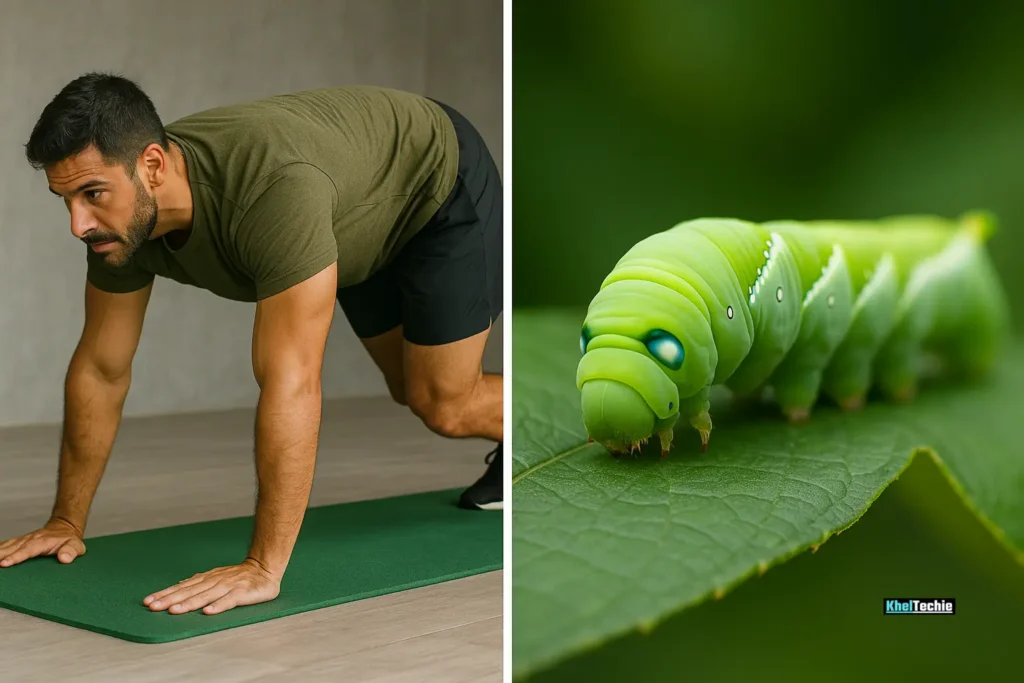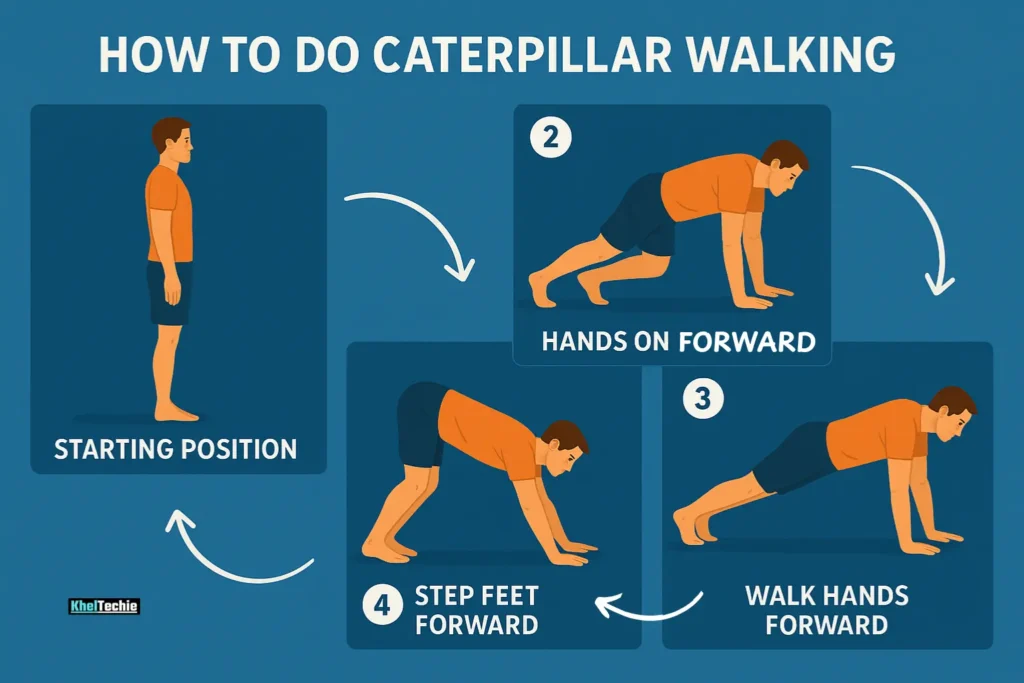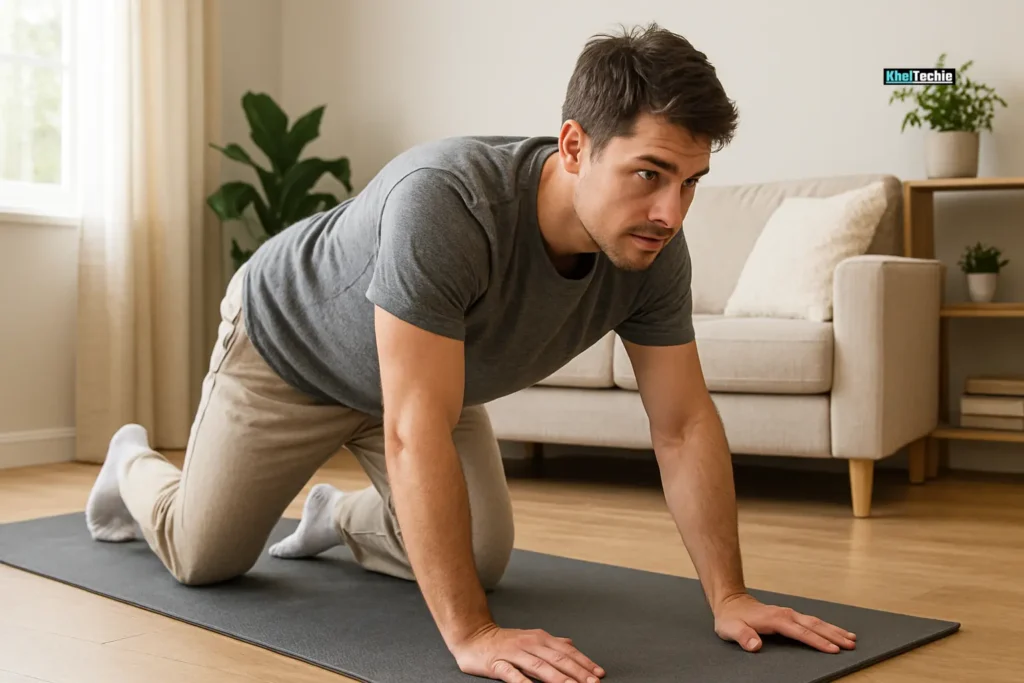Caterpillar Walking : Master Powerful Human Inchworm
Ever tried crawling across the floor like a caterpillar? Sounds silly, right? But what if I told you this quirky movement is gaining traction in fitness circles for building core strength, improving posture, and even helping kids with motor development?
If you’ve searched caterpillar walking online and found yourself confused by conflicting explanations or vague instructions, you’re not alone. That’s why we’re diving deep into everything you need to know about this surprisingly effective exercise, from how to do it correctly to who benefits most from it.
Whether you’re a parent teaching your child, a trainer adding variety to workouts, or someone recovering from an injury, understanding caterpillar walking can open up new possibilities for movement and strength.
Let’s get started!
Also read – High-Protein Breakfast Ideas for Busy Mornings

What Is Caterpillar Walking?
Caterpillar walking refers to a full-body movement pattern that mimics the way caterpillars move, slow, deliberate, and coordinated. It involves alternating arm and leg movements while staying low to the ground, often on hands and knees or in a standing squat position depending on the variation. Caterpillar walking sometimes called the inchworm or caterpillar stretch, does exactly that. In less than a minute you can lengthen tight posterior-chain muscles, wake up sleepy core stabilizers, and prime every major joint for whatever workout, or workday comes next.
It’s commonly used in:
- Early childhood development (to build motor skills),
- Functional fitness routines (like Animal Flow or primal movement training),
- Rehabilitation therapy (for balance and coordination),
- Yoga and Pilates warm-ups,
- Military and tactical training (to improve agility).
Why Is It Called Caterpillar Walking?
The name comes from the undulating motion of a real caterpillar moving forward, contracting and expanding its body segment by segment. In human terms, this translates to a rhythmic crawl using arms and legs alternately, engaging the entire kinetic chain from fingers to toes.
Why Caterpillar Walking Matters
Full-Body Payoff in 30 Seconds
- Hamstring length — EMG readings show peak activation at the end-range as you keep knees soft but straight.
- Shoulder girdle stability — Hand-walking loads serratus anterior and rotator-cuff muscles up to 60 % MVC during the plank phase (Journal of Insect Science biomechanical analogy).
- Core & scapular synergy — A week-long self-experiment by Tom’s Guide journalist Sam Hampson reported noticeable core engagement and reduced shoulder “crackle” after daily sets.
Injury-Proofing Through Fascial Lines
Your body’s posterior superficial line, running from plantar fascia to eyebrows, loves continuous tension. Long desk stints shorten that line. A slow Caterpillar walk re-hydrates fascia by oscillating tension and compression, similar to foam rolling but active.
Practical Carry-Over
- Deadlift lock-out speed (strong hip hinge).
- Yoga sun-salutation flow (smooth transitions).
- Obstacle-course racing (bear-crawl variations).

How to Do Caterpillar Walking: Step-by-Step Guide
Start slow, Your brain and body may feel out of sync at first, but practice improves coordination.
Equipment: Flat floor space the length of a yoga mat, optional socks off for foot proprioception.
Ready to give it a try? Let’s break down the process into simple, actionable steps.
| Step | Action | Coach’s Cue | Common Feel |
|---|---|---|---|
| 1 | Stand tall, feet hip-width, Inhale. | Grow an inch before you bend | Gentle stretch in calves |
| 2 | Soft-knees hinge, palms to floor (bend knees more if tight). | Send hips back, not down | Hamstring pull |
| 3 | Exhale, hand-walk forward to high-plank, shoulders over wrists. | Screw palms into floor, zip ribs to hips | Core brace, shoulder load |
| 4 | Pause 1sec, keep legs straight, take mini steps to bring feet toward hands. | Heels kiss floor lightly each step | Calves & lats stretch |
| 5 | When ankles nearly under hips, inhale, then repeat for 4–6 steps or 10 m. | Move like fluid — no jerks | Whole-body warmth |
Video reference – Caterpillar Walk
Progressions & Regressions
| Level | Variation | How | Goal |
|---|---|---|---|
| Beginner | Knee-bent inchworm | Allow generous knee flexion | Focus on core bracing |
| Intermediate | Caterpillar walk + push-up | Add one push-up at plank | Boost upper-body strength |
| Advanced | Loaded Inch-Out | Wear 10 kg weight-vest | Condition shoulders, trunk |
| Mobility-centric | Pike-press Walk | Elevate feet on step during hand-walk | Intensify hamstring stretch |
Common Mistakes to Avoid
Even experienced exercisers make errors when learning caterpillar walking. Here are the top ones to watch out for:
❌ Arching or Rounding the Back
- Why it’s bad: Puts pressure on the spine and increases injury risk.
- Fix: Keep your spine neutral, engage your core and look slightly ahead.
❌ Rushing the Movement
- Why it’s bad: You lose form and miss out on muscle engagement.
- Fix: Slow down and focus on quality over speed.
❌ Using Only Arms or Legs
- Why it’s bad: Creates imbalance and inefficient movement.
- Fix: Coordinate both upper and lower body, think whole-body teamwork.
❌ Holding Your Breath
- Why it’s bad: Causes tension and disrupts rhythm.
- Fix: Practice breathing in sync with each movement.
❌ Neglecting Warm-Up
- Why it’s bad: Increases risk of strains and cramps.
- Fix: Do light stretches and joint rotations before starting.

Who Should Try Caterpillar Walking?
Toddlers & Kids
Encouraging crawling helps develop bilateral coordination, shoulder girdle strength, and gross motor skills.
Athletes & Fitness Enthusiasts
Use caterpillar walking as part of warmups, mobility drills, or functional strength circuits.
Physical Therapy Patients
Ideal for relearning movement patterns after surgery or neurological events.
Seniors
Improves balance, coordination, and fall prevention.
Mindfulness Practitioners
Enhances presence and breath-body connection during movement.

Action Plan You Can Use Today
- Warm-Up Primer
- 30sec Jumping jacks
- 10 Cat-camels
- 2×8 m Caterpillar walks
- Strength Circuit (3 rounds)
- 8 Push-ups
- 30sec Goblet squat hold
- 10 m Caterpillar walk + push-up
- Cool-Down
- 60sec Seated forward fold
Also read – Healthy Lunch Ideas for Busy Professionals
Final Thoughts: Caterpillar Walking Is More Than Just a Crawl
At first glance, caterpillar walking seems like a silly toddler activity. But dig deeper, and you’ll find a powerful tool for building strength, balance, and body awareness. Whether you’re rehabbing an injury, training for performance, or just having fun, this movement has something to offer everyone.
So next time you see someone crawling around, don’t laugh, they might just be ahead of the curve.
Frequently Asked Questions
Is Caterpillar walking the same as inchworms?
Mostly, yes. Fitness circles often use the terms interchangeably. However, Caterpillar walks emphasize a smoother rolling spine and sometimes include the feet-walk phase, whereas inchworms may simply reverse the hand-walk to return to standing.
How many reps should I do?
For warm-ups, 2 sets of 8–10 meters works. For conditioning circuits, try 30 seconds on / 30 seconds off.
Can I use it instead of static hamstring stretches?
Absolutely. Dynamic stretching before workouts preserves power whereas long static holds (over 60 s) can dampen force production.
What if my wrists hurt?
Elevate hands on parallettes or dumbbells to keep wrists neutral, or switch to fists.
Does it build muscle?
Indirectly. Time-under-tension for shoulders, serratus, and core is significant, but it’s more a mobility-stability drill than hypertrophy move.
How does it compare to yoga Sun A salutations?
Sun A flows include upward-dog back-extension; Caterpillar walks stay neutral-spine and load anterior core more.
What Surfaces Are Best for Caterpillar Walking?
Carpet or yoga mat – ideal for beginners
Grass or turf – great for outdoor fun
Smooth floors – challenge for advanced users
Avoid hard concrete or uneven surfaces that could cause friction burns or slips
How Is Caterpillar Walking Different from Bear Crawls?
Bear crawl : On hands and feet, knees off the ground — more intense.
Caterpillar crawl : On hands and knees — slower, controlled, beginner-friendly.
Both are great, but caterpillar walking is easier to learn and less stressful on the wrists.
Can I Do Caterpillar Walking Every Day?
Yes! It’s low impact and gentle on the joints. Just listen to your body and rest if soreness occurs.
What Muscles Does Caterpillar Walking Work?
Caterpillar walking engages:
Core (abs, obliques, lower back)
Shoulders and triceps
Glutes and hamstrings
Hip flexors and calves
It’s a full-body exercise that also activates stabilizing muscles often neglected in traditional workouts.





Pingback: Brisk Walking For Health Insurrection: Rebel Against Fatigue